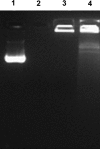Intranasal vaccination with chitosan-DNA nanoparticles expressing pneumococcal surface antigen a protects mice against nasopharyngeal colonization by Streptococcus pneumoniae
- PMID: 21047997
- PMCID: PMC3019786
- DOI: 10.1128/CVI.00263-10
Intranasal vaccination with chitosan-DNA nanoparticles expressing pneumococcal surface antigen a protects mice against nasopharyngeal colonization by Streptococcus pneumoniae
Abstract
Streptococcus pneumoniae is a respiratory pathogen, and mucosal immune response plays a significant role in the defense against pneumococcal infections. Thus, intranasal vaccination may be an alternative approach to current immunization strategies, and effective delivery systems to mucosal organism are necessary. In this study, BALB/c mice were immunized intranasally with chitosan-DNA nanoparticles expressing pneumococcal surface antigen A (PsaA). Compared to levels in mice immunized with naked DNA or chitosan-pVAX1, anti-PsaA IgG antibody in serum and anti-IgA antibody in mucosal lavages were elevated significantly in mice immunized with chitosan-psaA. The balanced IgG1/IgG2a antibody ratio in serum, enhanced gamma interferon (IFN-γ) and IL-17A levels in spleen lymphocytes, and mucosal washes of mice immunized with chitosan-psaA suggested that cellular immune responses were induced. Furthermore, significantly fewer pneumococci were recovered from the nasopharynx of mice immunized with chitosan-psaA than for the control group following intranasal challenge with ATCC 6303 (serotype 3). These results demonstrated that mucosal immunization with chitosan-psaA may successfully generate mucosal and systemic immune responses and prevent pneumococcal nasopharyngeal colonization. Hence, a chitosan-DNA nanoparticle vaccine expressing pneumococcal major immunodominant antigens after intranasal administration could be developed to prevent pneumococcal infections.
Figures






Similar articles
-
Mucosal immunization with PsaA protein, using chitosan as a delivery system, increases protection against acute otitis media and invasive infection by Streptococcus pneumoniae.Scand J Immunol. 2015 Mar;81(3):177-85. doi: 10.1111/sji.12267. Scand J Immunol. 2015. PMID: 25565478
-
Induction of systemic and mucosal immune response and decrease in Streptococcus pneumoniae colonization by nasal inoculation of mice with recombinant lactic acid bacteria expressing pneumococcal surface antigen A.Microbes Infect. 2006 Apr;8(4):1016-24. doi: 10.1016/j.micinf.2005.10.020. Epub 2006 Jan 18. Microbes Infect. 2006. PMID: 16549380 Free PMC article.
-
Protective Immune Responses Elicited by Fusion Protein Containing PsaA and PspA Fragments.Immunol Invest. 2015;44(5):482-96. doi: 10.3109/08820139.2015.1037956. Immunol Invest. 2015. PMID: 26107747
-
Understanding host immune responses to pneumococcal proteins in the upper respiratory tract to develop serotype-independent pneumococcal vaccines.Expert Rev Vaccines. 2020 Oct;19(10):959-972. doi: 10.1080/14760584.2020.1843433. Epub 2020 Nov 8. Expert Rev Vaccines. 2020. PMID: 33107359 Review.
-
The potential for using protein vaccines to protect against otitis media caused by Streptococcus pneumoniae.Vaccine. 2000 Dec 8;19 Suppl 1:S87-95. doi: 10.1016/s0264-410x(00)00285-1. Vaccine. 2000. PMID: 11163470 Review.
Cited by
-
Transferrin conjugation confers mucosal molecular targeting to a model HIV-1 trimeric gp140 vaccine antigen.J Control Release. 2012 Mar 10;158(2):240-9. doi: 10.1016/j.jconrel.2011.11.009. Epub 2011 Nov 15. J Control Release. 2012. PMID: 22119743 Free PMC article.
-
Molecular adjuvant interleukin-33 enhances the antifertility effect of Lagurus lagurus zona pellucida 3 DNA vaccine administered by the mucosal route.Braz J Med Biol Res. 2013 Dec;46(12):1064-1073. doi: 10.1590/1414-431X20133126. Epub 2013 Dec 10. Braz J Med Biol Res. 2013. PMID: 24345916 Free PMC article.
-
Polymeric Nanoparticle-Based Vaccine Adjuvants and Delivery Vehicles.Curr Top Microbiol Immunol. 2021;433:29-76. doi: 10.1007/82_2020_226. Curr Top Microbiol Immunol. 2021. PMID: 33165869 Free PMC article. Review.
-
Micro- and Nanosized Particles in Nasal Mucosa: A Pilot Study.Biomed Res Int. 2015;2015:505986. doi: 10.1155/2015/505986. Epub 2015 Jun 1. Biomed Res Int. 2015. PMID: 26125023 Free PMC article.
-
Polymeric Nanoparticles for Inhaled Vaccines.Polymers (Basel). 2022 Oct 21;14(20):4450. doi: 10.3390/polym14204450. Polymers (Basel). 2022. PMID: 36298030 Free PMC article. Review.
References
-
- Alpar, H. O., S. Somavarapu, K. N. Atuah, and V. W. Bramwell. 2005. Biodegradable mucoadhesive particulates for nasal and pulmonary antigen and DNA delivery. Adv. Drug Deliv. Rev. 57:411-430. - PubMed
-
- Arêas, A. P., M. L. Oliveira, E. N. Miyaji, L. C. Leite, K. A. Aires, W. O. Dias, and P. L. Ho. 2004. Expression and characterization of cholera toxin B-pneumococcal surface adhesin A fusion protein in Escherichia coli: ability of CTB-PsaA to induce humoral immune response in mice. Biochem. Biophys. Res. Commun. 321:192-196. - PubMed
-
- Aspden, T. J., J. D. Mason, N. S. Jones, J. Lowe, O. Skaugrud, and L. Illum. 1997. Chitosan as a nasal delivery system: the effect of chitosan solutions on in vitro and in vivo mucociliary transport rates in human turbinates and volunteers. J. Pharm. Sci. 86:509-513. - PubMed
-
- Basset, A., C. M. Thompson, S. K. Hollingshead, D. E. Briles, E. W. Ades, M. Lipsitch, and R. Malley. 2007. Antibody-independent, CD4+ T-cell-dependent protection against pneumococcal colonization elicited by intranasal immunization with purified pneumococcal proteins. Infect. Immun. 75:5460-5464. - PMC - PubMed
-
- Bernatoniene, J., and A. Finn. 2005. Advances in pneumococcal vaccines: advantages for infants and children. Drugs 65:229-255. - PubMed
Publication types
MeSH terms
Substances
LinkOut - more resources
Full Text Sources
Other Literature Sources
Medical
Molecular Biology Databases
Miscellaneous

